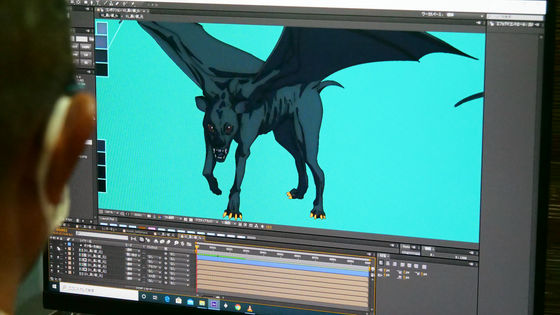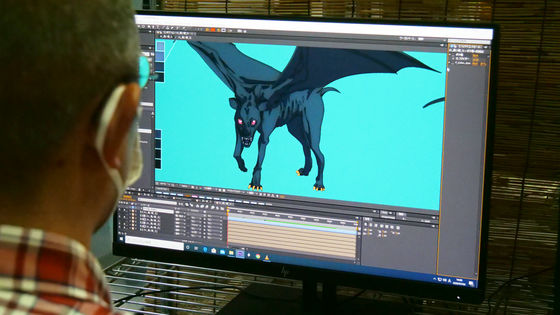Interview with Shinyo Kondo, director of photography for 'Sorcerous Stabber Orphen Hagure Journey Kimrak', about the work of 'shooting' that enhances the coolness of drawing

A series of interviews with the staff involved in the production of the TV anime ' Sorcerous Stabber Orphen Hagure Journey Kimrak Hen ' which will be broadcast from January 20, 2021 (Wednesday). Following
TV anime 'Sorcerous Stabber Orphen Hagure Journey Kimrak Hen' Official Website
http://ssorphen-anime.com/
GIGAZINE (G):
First of all, let me show you what kind of work you are doing in the process of 'shooting' ...
Cinematographer Shinyo Kondo (Kondo):
This is the base picture.

Kondo:
I pick up the colors and lightly add texture, but since there are many night scenes, I make my eyes glow red so that they stand out even in the distance.
Before keeping an eye out

After shining

G:
I see, based on the color designation, the fine appearance is processed in the shooting process. Do you unify the condition of such processing with 'Let's go like this' in advance? Or will the workers adjust based on their experience?
Kondo:
In the case of Studio Dean's photography department, I first instructed that 'this scene is this kind of color, this texture'. I look at the final result, make corrections if necessary, and send it to the editor.
G:
Since magic comes out in 'Sorcerous Stabber Orphen Hagure Journey', I have the impression that it is often done in the shooting process. How does it compare to other works? I feel that a lot of things related to light will come out ...
Kondo:
I agree. In the magic part, it may take some work process.
G:
Now, as a reference, I'm showing you a scene where the water splits, but the impression is completely different before and after the shooting process. Does this change so much just by the effect? There is a difference as if the water itself was redrawn.
Before shooting the scene

Kondo:
The materials are the same.
G:
This time, I showed you the process of shooting work, but I hear that you will be in charge of drawing in the form of 'I will do it from here to here', but in the case of shooting, how many people and how Do you share it?
Kondo:
Since I'm also working on other works, there are people who come in for help in addition to the people who are shooting in the main, and the number of people varies, but it is about 3 to 4 people. Depending on the work, there are cases where one person is in charge depending on the scene, but in the case of 'Sorcerous Stabber Orphen Hagure Journey', to some extent, I ask myself to 'I want you to do it like this' and work on it. It takes the form of adjusting with.
G:
I heard from Director Hamana that the weight of the story is different between the first period and the Kimrak edition, so the appearance will also be different. Is there any difference in shooting?
Kondo:
The basics of shooting are the same, but there are some subtle differences in terms of effects, such as strengthening a certain layer in the Kimrak edition.
G:
In 'Sorcerous Stabber Orphen Hagure Journey', a beautiful mandala-like magical composition is developed when magic is exercised. That is……

Kondo:
Separately, there is one that was made with a 3D model like this.

Kondo:
In this way, it can be used in any direction. In the magic itself, after receiving materials such as effects, flames and light in the drawing, the effect is added by adding or adding light in the shooting.

G:
By adding effects to the base such as flames created by drawing, magic is literally created in three dimensions. I have been shown various materials, but since shooting is the department that finally synthesizes these, I think that a large amount of materials are gathered and it is difficult not only to work but also to manage. Are there any techniques or tips for managing them?
Kondo:
Rather, I would like you to tell me if you have any tips ... (laughs) 'Orphen' has various magics and effects, so I try to organize it as much as possible, but if it is deep, the folder structure will be complicated. I wonder if it's difficult for workers to use it.
G:
It's a considerable amount, isn't it?
Kondo:
Well, I'm not usually aware of the size, so I can't tell how much it is until I actually count it, but there are about 250 to 300 cuts for each episode, and the background and cells are in each episode folder. Because ... it's a good amount.
G:
I'm being interviewed today, so I'm being shown the work in the studio. Is the work done remotely?
Kondo:
Well, since I use my company's PC remotely, I can work even if the specifications of my home PC are not so high. However, I have the impression that the work efficiency has dropped a little. If the amount made by the company is 10, it will be 7 or 8 if it is remote.
G:
I'm a little away from Orphen, but I saw Mr. Kondo being credited for drawing that it was an old work.
Kondo:
Yes, at first I was in Studio Dean's drawing. When I started a new digital department in a company, I was asked 'How about?' And I decided to try it because it looked interesting.
G:
So that's it. I think you've been 'shooting' for about 30 years, but what has changed in the shooting section?
Kondo:
I don't know a little about shooting before digitization because I haven't worked on it even though I was shown the equipment, but after digitization, the first software I used was After Effects, which is basic. The process hasn't changed.
G:
What is the point of the scene in 'Orphen' where you want to see the work of shooting?
Kondo:
As much as possible, I try not to make the picture light. There are many dark scenes in the Kimrak edition, but I wonder if there are places where it looks beautiful by adding processing.
G:
When the whole work, not just 'Ophen', is a solid picture in total, can you think that the shooting work is going well?
Kondo:
In that respect, it is still 'drawing'. It feels like shooting is 'adding' to the place where the effects are drawn firmly and coolly.
G:
It's a role that doubles the coolness of drawing.
Kondo:
I agree.
G:
Is there anything that people who want to shoot should learn, or should they do it before they enter the anime industry?
Kondo:
I'm telling people who have been interviewed that I should watch various movies. After that, look around yourself. How the signal is blinking and what the natural phenomenon looks like. I think it's a good idea to have an observation eye.
G:
Rather than learning about classroom lectures, it is better to improve your observation eyes in your daily life.
Kondo:
The flashy effects are interesting, but not so, the plain parts also support the quality of the work. So as not to destroy the work.
G:
Since the Kimrak edition will start broadcasting from January 20, 2021, I am looking forward to seeing how the processing shown earlier will look on the actual screen. Thank you for today.
The interview continues.
·to be continued
Related Posts:








